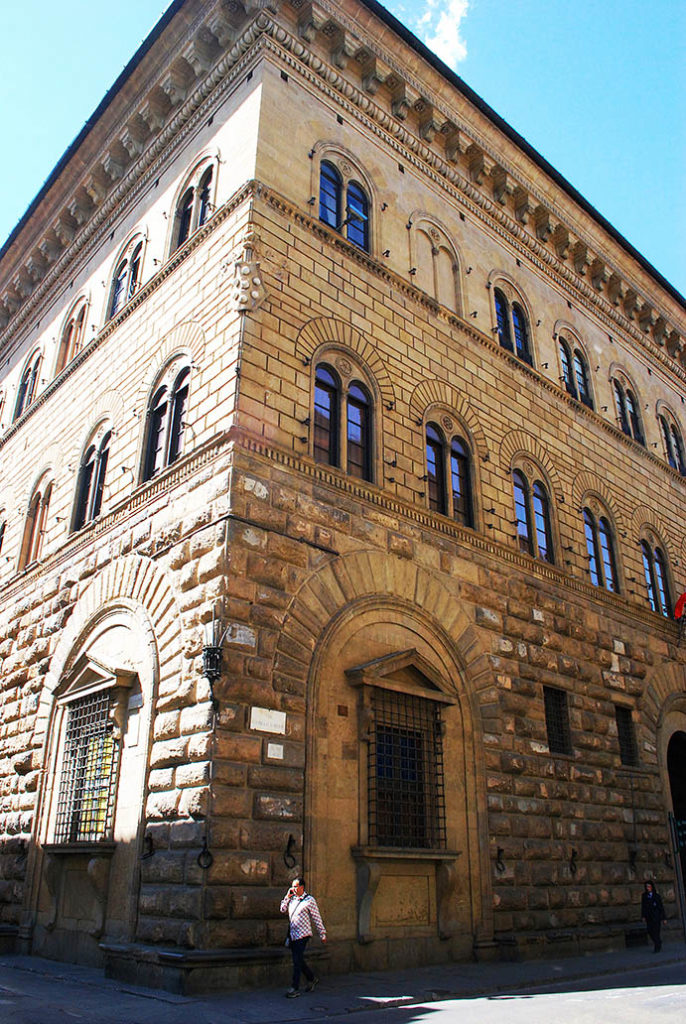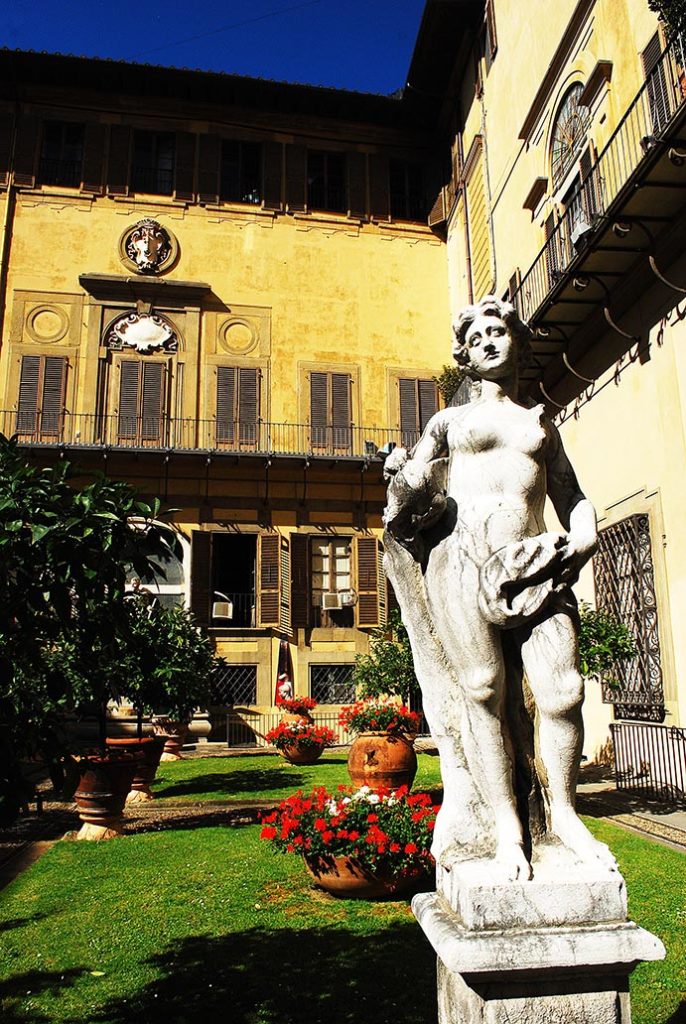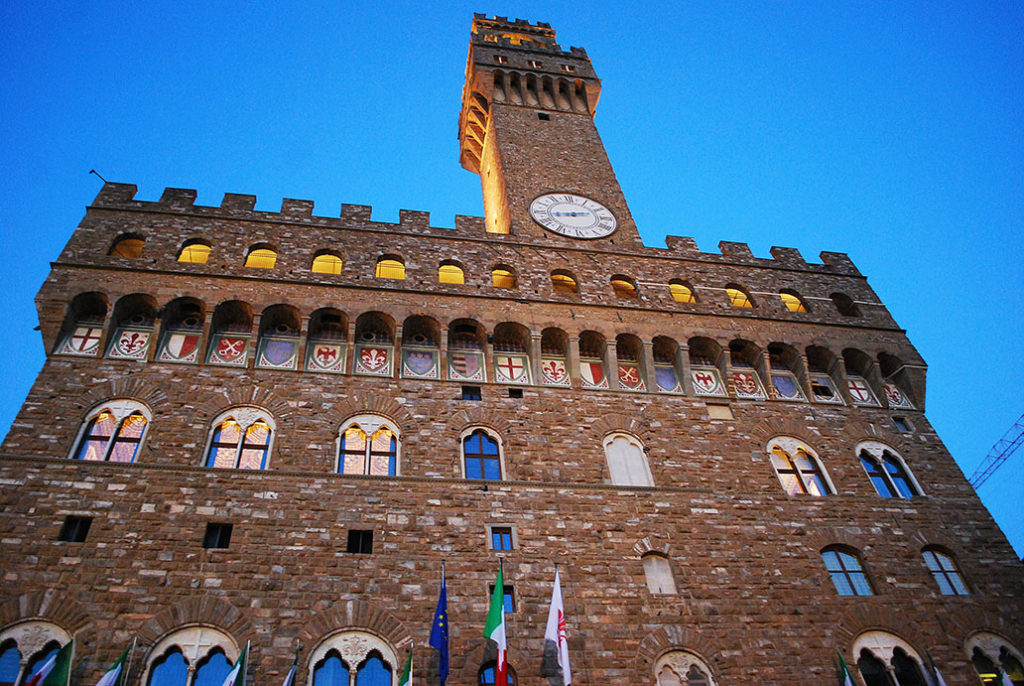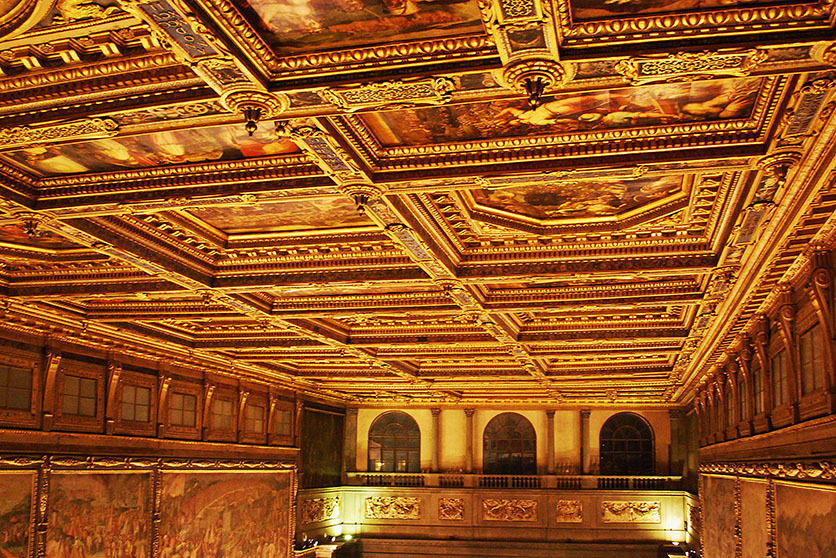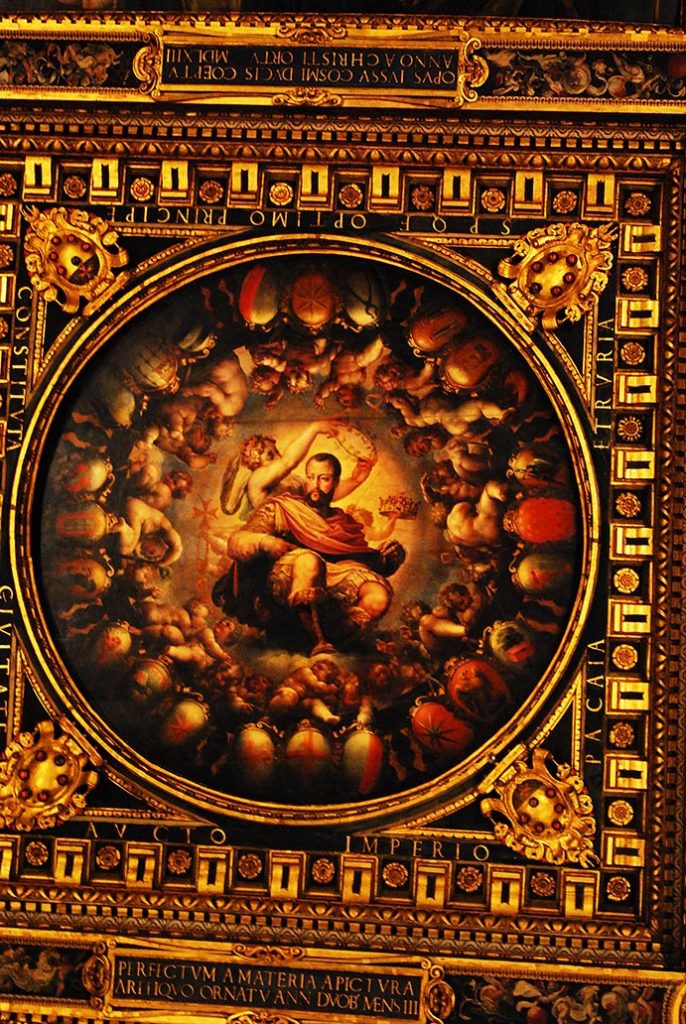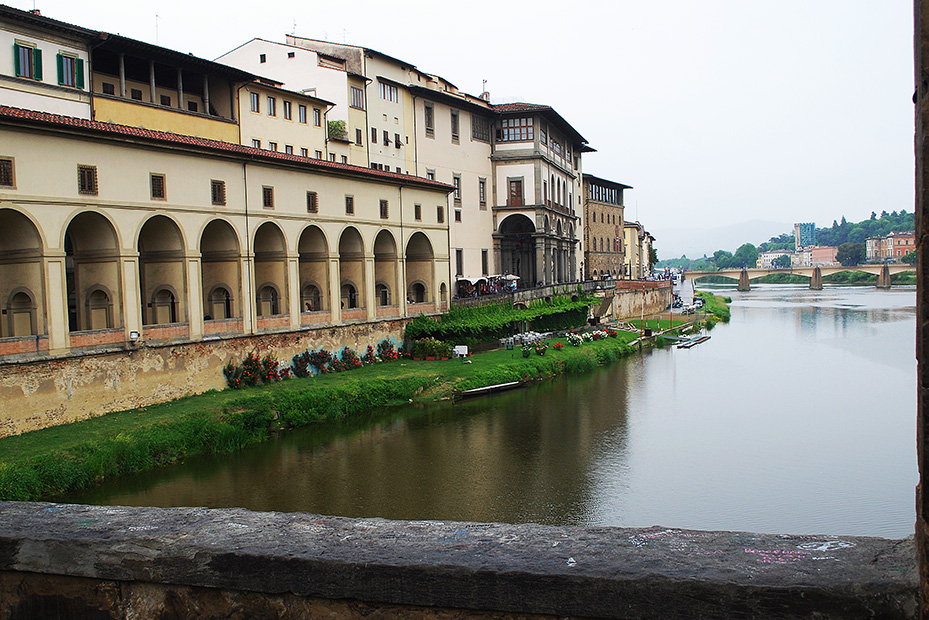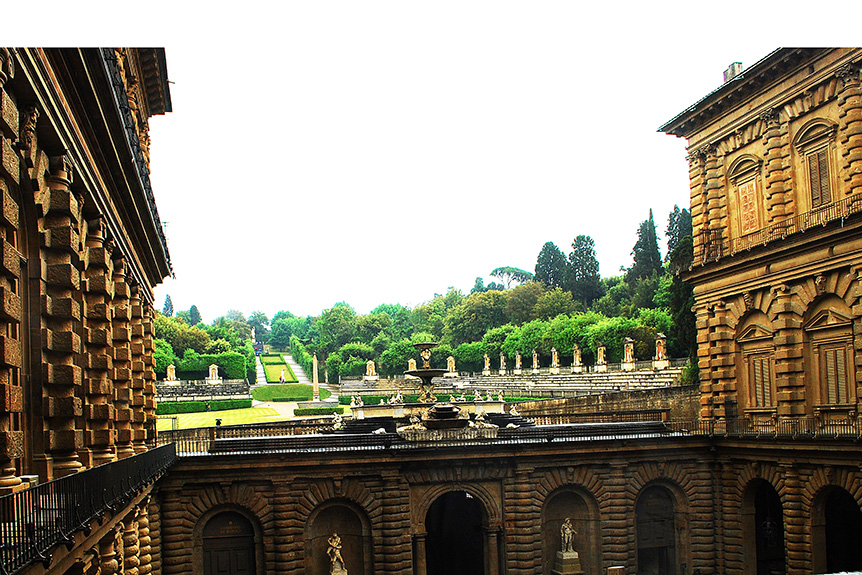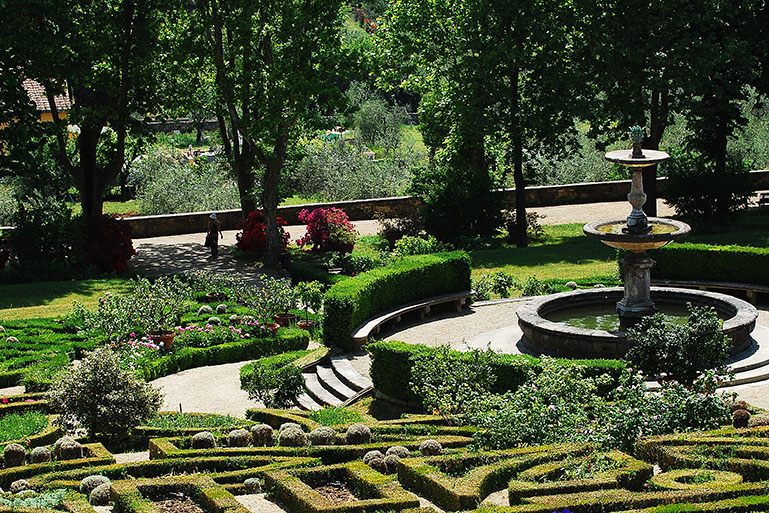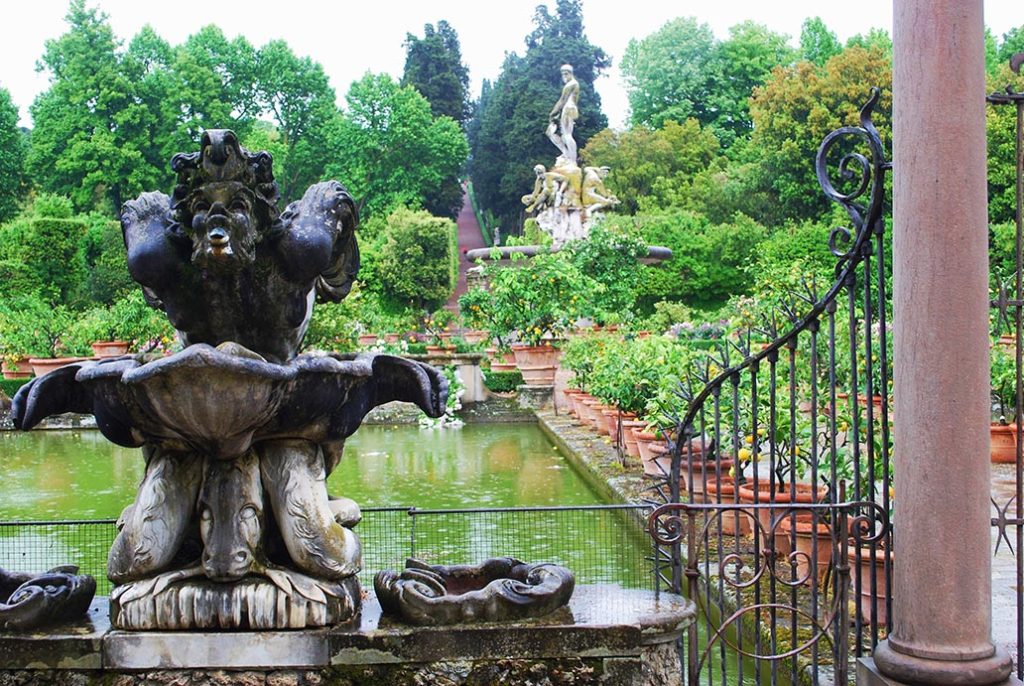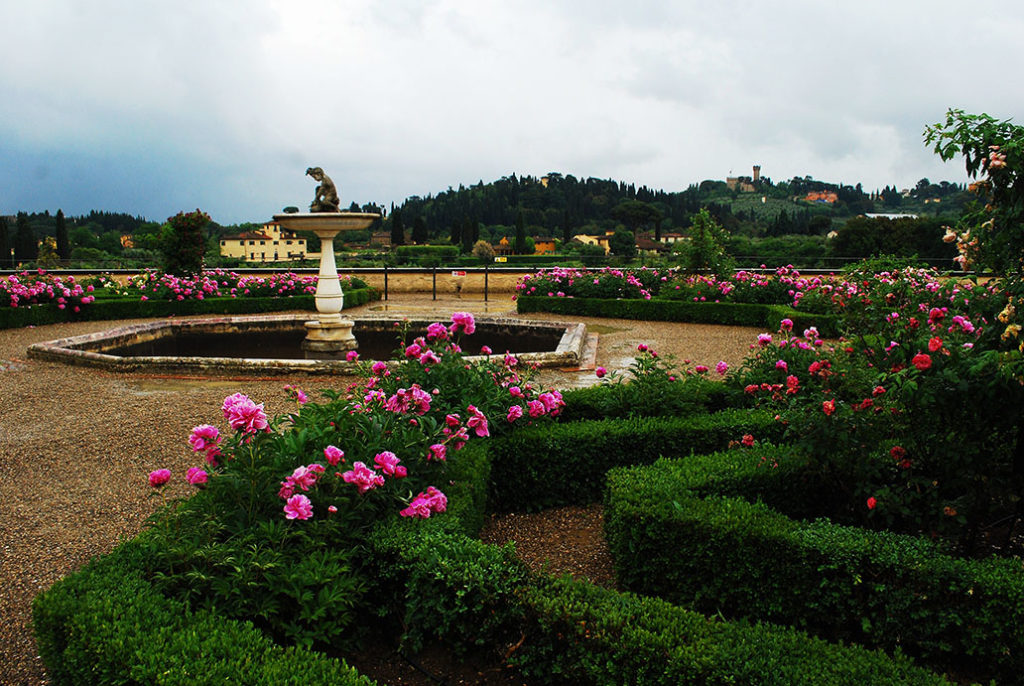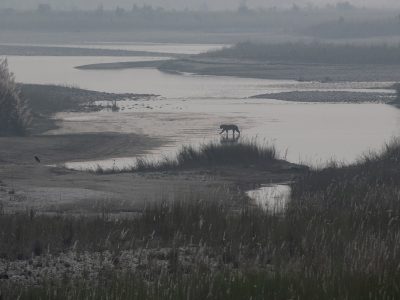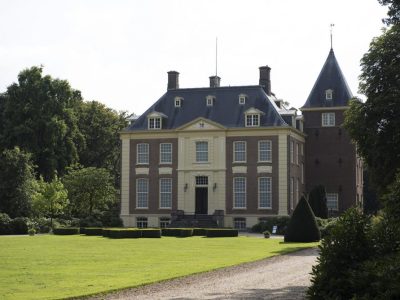They are inextricably linked: Florence and the Medici. For almost three centuries, the famous family played a cunning political game that took them to great heights. They made themselves immortal as patrons of great masters such as Michelangelo, Brunelleschi, Botticelli, Filippo Lippi, Vasari and Leonardo. Their artistic legacy is best known by visiting their palaces and country houses, such as the Palazzi Riccardi, Vecchio, Pitti and Villa La Petraia. There you can taste the richness of an extinct exceptional family, which after four hundred years is still alive and kicking.
Text & photography: Angelique van Os
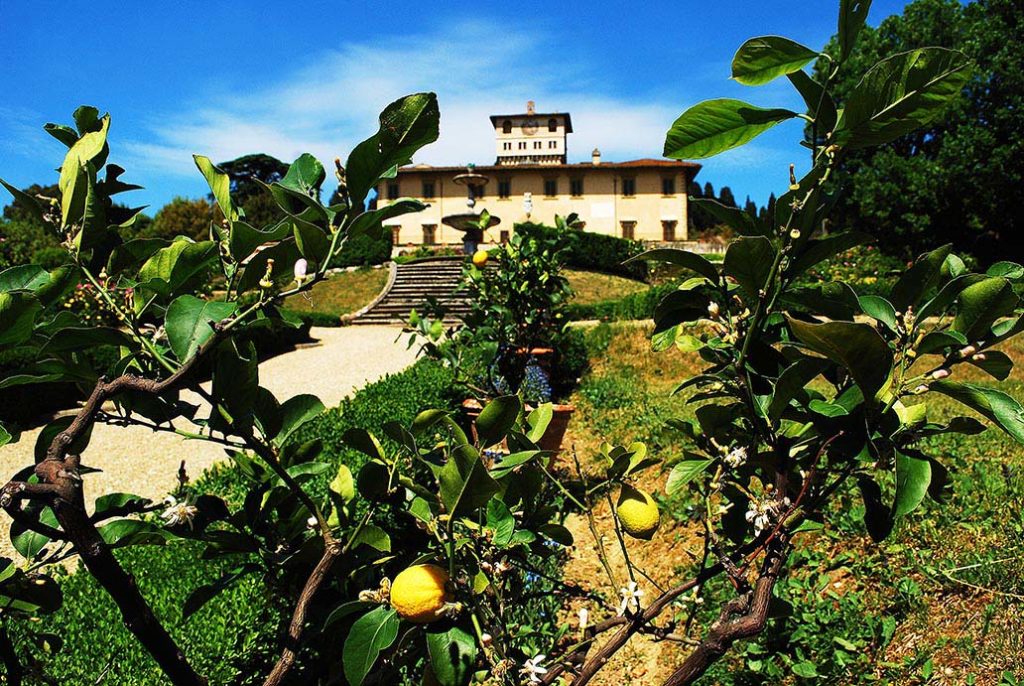
It is quiet in the narrow streets that become winding steeper and reach the hills of Monte Morello. Occasionally a Vespa races by and after following a metre-long grey wall the high iron fence of Villa La Petraia looms up. After a short, steep climb, the cool shadows of the trees meet me. On the hill the villa shows off on the horizon, with a view over ‘her’ city, Florence. In the distance, Brunelleschi’s dome stands out above everything else. La Petraia was one of the many country houses of the Medici, the famous family that ruled Florence during the Renaissance. Just outside the city walls the dynasty owned eleven villas and elsewhere in Tuscany another thirteen! In 1544 the house came into the possession of Duke Cosimo I and remained in the family until the middle of the seventeenth century. Then the Lorraine and Vittorio Emanuele II of Savoy took care of it. La Petraia is one of the best preserved houses of the Medici. The beautiful symmetry and terraces of the sixteenth-century garden, equipped with ponds, a fountain, herbaceous plants and fruit trees, fit perfectly with the austere and stately building. Behind the blindfolded windows of the entrance, however, lies a world of pure beauty. The square courtyard has beautiful decorations, a huge chandelier and is covered by a glass dome that the Savoyes had placed on it in 1872 for the wedding of son Emanuele di Mirafiori.
Pr-medium
Despite the intervention of later owners, the house exudes the spirit of its owner. Those who get to know the Medici know that their artistic wealth is a symbol of power. The embrace and financing of great artists turned out to be an ideal means of public relations, which other wealthy families and clerics also applied in, for example, churches. Partly because of their sincere interest in art and science, the Medici turned out to be responsible for countless important works from the Renaissance. In La Patraia Cosimo’s grandson, Lorenzo (1599-1648), had the loggias of the imposing hall immortalised with beautiful frescoes. The paintings are entitled Fasti Medicei(1637-46) and refer to the triumphs of family history. Baldassarre Franceschini ‘Il Voterrano’, for example, depicted the meeting between Pope Leo X and Francis I of France, the victory of Cosimo I over Siena and Catherina and her children. It is a breathtaking spectacle that you keep staring at with an open mouth. Cosimo Daddi (1590) decorated the hall which, among other things, depicts the victory over Jerusalem. The rooms are equally pleasing to the eye. The interior and furniture of the various rooms are mainly neoclassical. The old chapel (1589-94) is richly decorated by Bernardino Poccetti with angels and the life story of Christ. Daddi painted the ceiling with the Glorification of the Holy Spirit. From the open balcony on the first floor, you can look out over the courtyard, which occupies a central position. What an entrance, and this is only the beginning.
“Behind the blinded windows of the entrance lies a world of pure beauty”
Flavors
In Florence, traces of the Medici can be found everywhere, such as their facial weapons on many buildings. To follow in their footsteps, you should start in Palazzo Medici Riccardi, which was their first ‘family home’. Three generations, surrounded by loyal friends and artists, found their home here. Designed and built by Michelozzo di Bartolomeo (1444) on behalf of Cosimo Il Vecchio (the Ancient), this relatively sober and classic-looking palazzo, with its three-storey facade, is one of the first pro-totypes in Renaissance architecture. The halls and rooms were mainly decorated in Baroque style by the later inhabitants, the Riccardi family, but the Medici have left their mark superbly. Next to Michelozzo’s beautiful courtyard with ornate arcades and Donatello medallions, the Chapel of the Epiphany is the absolute highlight. Because this palace is less well known to tourists, you may have the chapel all to yourself. And what a privilege that is! The frescoes by Fra Angelico’s pupil, Benozzo Gozzoli, look magical and exotic. The three walls tell the story of the journey of the three kings to Bethlehem and are so lavishly decorated that you almost become hypnotised by the inexhaustible details. The full colours, the richness of gold stitched fabrics, the graceful lines of man and animal and the romantic hilly landscapes, bring the spectacle to life. The altarpiece, a copy of The Adoration of the Childby Fillipo Lippi, completes the chapel. Of course the scene is bursting with symbolism, because if you look closely you will recognize various faces of the Medici on the eastern wall. The youngest king is a portrait of Lorenzo (Il Magnifico). The result behind him is his father Piero, who had the frescoes executed, and Cosimo the Elder. The portraits represent the growing economic and political power of the family. And that was important, because this space also served as a foyer for important figures who regularly visited the scene.
Splendour and splendour
Just a ten-minute walk from the first house is located on the lively Piazza Della Signoria, the imposing Palazzo Vecchio (the old palace). In the fourteenth century this was the most important government building and served as the seat of the Signoria, the republican government. The Italian Parliament also sat there for a short time when Florence was Italy’s capital from 1865 to 1870. The old town hall, which still fulfils its function, was built in 1322. Its 94-metre-high bell tower served as a watchtower to spot hostile troops in time and warn the population. Cosimo I, who commissioned his house architect and painter, Giorgio Vasari, to add bombastic frescoes and paintings to the ceilings and walls around 1540, took over the palace. He did an excellent job, because although Palazzo Vecchio has less prestige than the Uffizi or Palazzo Pitti, there is plenty to discover. As soon as you enter the Salone dei Cinque- cento (Room of the Five Hundred, 1495), you will be caught up in impressive battles that depict the victories of the Medici in Pisa and Siena, depict events in Florence and tell about allegories of Cosimo’s life. I almost get cramps in my neck from staring up at the 39 panels in the ceiling. In the middle ceiling circle, the client himself is crowned by an angel depicting Florence. Vasari had the room raised by no less than eight metres (!) and, together with his students, completed the paintings within three years. There are various sculptures in front of the murals, such as Michelangelo’s Victory.
In the apartments of Pope Leo X, his ancestors will be honoured even more. The private rooms of Cosimo’s wife, Eleonora of Toledo, have not only beautiful ceilings and walls covered with silk, but also beautiful furniture, such as a typical Floren-tin cabinet of pietre dure (with stone inlays) with a beautiful image of La Petraia. Elenora’s richly decorated chapel by Agnolo Bronzino (1540-45) is also a gem. I walk along the salons of the Elements and mythical stories on the second floor and end up in the oldest part, the Sala dell’Udienza (the meeting room of the six Priori), which has a ceiling frame of pure gold. And if that’s not enough, the Sala dei Gigli, with Donatello’s menacing Judith at its centre, is surrounded by walls of silk blue lilies. The Geographic Room, with its impressive wooden globe and detailed maps of the world, forms a worthy finale. Cosimo I, however, did not consider Palazzo Vecchio worthy enough to receive guests, on to Palazzo Pitti!
Cosimo and his family had many enemies, so he had Vasari build a private passageway almost a kilometre long, which runs from the Uffizi over the Ponte Vecchio to Palazzo Pitti.
Private Corridor
To see the dizzying content of Palazzo Pitti, I get help from guide Samantha Para. Without a guide or preparation you won’t see the forest through the trees in this immense museum with its lavish art galleries. While a heavy rainstorm forces us to buy an umbrella, Para tells me about the history while walking. The palazzo was probably built by Brunelleschi for Luca Pitti, who wanted to surpass the rule of the Medici. However, the wealthy merchant almost went bankrupt at the cost of the unfinished stall. After his death in 1473 his family sold it in 1550 to Eleonora of Toledo. Suddenly we stop in the middle of Ponte Vecchio. The guide tells an interesting detail that you can walk past without knowing it. She points up to the side corridors of the Uffizi, which Cosimo I had built by Vasari. At that time the Uffizi Gallery served as an office for its government purposes. Cosimo and his family had many enemies and because of that he had Vasari build a private corridor of almost a kilometer long, which runs from the Uffizi over the Ponte Vecchio to Palazzo Pitti. This made it possible to move around unseen and safely. It is striking that the Ponte Vecchio is one of the few bridges that was spared during the Second World War. Rumour has it that the Nazis used the passage as an escape route and that even Hitler and Mussolini met there safely. On the other side of the Arno, I constantly see the private corridor in the corner of my eye. The route runs through dozens of houses.
Official audiences
From a narrow street the immense Palazzo Pitti emerges from nowhere. It is hard to imagine that this place mainly served as a hotel for special guests, special occasions or for official audiences. Samantha Para tells for example that the imposing courtyard of Bartolomeo Ammannati, which overlooks the beautiful Boboli garden from the first floor, was transformed into a spectacular water basin for the wedding of son Ferdinando I and his Royal French heiress Christina of Lorraine. The courtyard was filled to a height of about three metres with water, where sea battles were reenacted in honour of the bride and groom who went to live there permanently. The couple stayed mainly on the first floor in the left wing. Their children were one floor higher. For two centuries, Pitti was the home of the last Medicine descendants. After that many different residents lived at the court: from the Lorraine, to the Savoy dynasty. Elisa Bonaparte in particular, told my guide: “Elisa didn’t like Italian art and destroyed many frescoes. Unfortunately, she had several rooms redesigned in a superfluous Neoclassical style.” The Pitti was constantly rebuilt and expanded and therefore has many different faces in terms of interior.
Green fairytale courtyard
Despite the bad weather, which is slowly clearing up, I decide to explore the garden further. The paths are remarkably steep and vary from wide to narrow. Not very attractive for people with mobility problems. In contrast to the palace it is nice to wander around unprepared and to see where you end up. Het groene sprookjeshof telt ruim 45 hectare en is oorspronkelijk ontworpen door Niccolò Tribolo, die in opdracht van Cosimo I ook verantwoorde-lijk was voor de tuin van Villa in Castello (vlakbij Petraia).The green fairytale courtyard covers more than 45 hectares and was originally designed by Niccolò Tribolo, who was also responsible for the garden of Villa in Castello (near Petraia) by order of Cosimo I. Via a side road I walk past the coffee house, which looks sad because of the grey dripping weather. The advantage is that it is quiet in the park. I walk up until I arrive at a spiral staircase via a sheltered path. My curiosity is rewarded with a beautiful view. In front of me is the Porcelain Museum with its Giardino del Cavaliere: an exotic and flowering rose garden, surrounded by a breathtaking green valley. Cardinal Leopoldo De’ Medici, among others, used the museum as a reception room for scientists. Now there are exhibitions of precious porcelain, although the beautiful tableware does not beat the view. I go back downstairs and look out on the deserted amphitheatre and the back of the Pitti through several layers of terraces.
I turn further to the right and end up at the right wing of the building. The dark sky hangs threateningly above the city that looms up from this vantage point. A bit back I walk over the Cipreslaan, with its beautiful Roman statues, more than five hundred meters steeply down. Take a side street here, because it’s the densely vegetated avenues that let you wander through the garden and end up in romantic courtyards or small inner courtyards. The grand finale can be found at the end of the avenue at the elegant fountain and statue group Vasca dell’Isola, which is a small island. Please note that the fountain can only be visited in May and June.
The Palatine art gallery, with grand works from Titian and Raphael to Rubens and the Palatine art gallery, with grand works from Titian and Raphael to Rubens and Caravaggio, is flooding the senses. Para tells a nice detail about the portrait of Tommaso Inghirami (1510), who was a friend of Pope Leo X. “Do you see that Tommaso’s left eye is slightly different? The man seems to have been rather cross-eyed. Raphael wanted to portray his client realistically, but didn’t want to offend him by only painting him from the side. That’s why he had him look up, so that his entire face is visible, and his eye is less in the foreground.” The art historian tells one story after another. For example, she points to the small doors that are woven into the walls. These were the entrances with corridors and rooms for service behind them. There is so much to see that we don’t even get to the modern art gallery on the second floor. The rooms are so richly decorated and full of paintings that it makes me dizzy before my eyes. I need some fresh air. Via the left wing of the impressive Boboli gardens we descend. In the sixteenth century Boboli referred to wooded areas and thus got her name. As in art, the Medici were one of the first wealthy families to put Italian garden architecture on the map and serve as role models in Europe. Hidden in a corner is the Grand Grotto by Bernardo Buontalenti (1583-87), which according to Para was the first step towards the Baroque. The cave also has those search pictures that refer symabolically to De Medici. Pietro Mati took care of the interior, which looks almost grotesque with the strange spongy clay shapes that represent figures and animals. The frescoes were added much later by Bernardino Poccetti (1886-87). When it starts to plummet, we hide under the facade and I see a small side door. To my surprise this is the door to Vasari’s private corridor. If only we could peek behind it…
Last resting place
After the transhipment of Palazzo Pitti and her magnificent Bobolituin, I say goodbye to the Godfathers of the Renaissance at their final resting place: San Lorenzo and the Medici Chapel, where almost all family members are buried. The first parish church is one of the most important and oldest buildings in Renaissance architecture and is a symbol of the history of the Medici. Brunelleschi rebuilt the cathedral by order of Giovanni around 1418, and Michelangelo designed the façade and the library where family manuscripts were kept more than a century later. Unfortunately, the library is closed and I still can’t see the famous Mannerist staircases. But there is plenty to see, San Lorenzo is full of art treasures, from Donatello and Fillippo Lippi to Agnolo Bronzino. Then I walk outside, past the busy tourist market, where I get access to the chapel via a side entrance. The metre-high Cappella dei Principi, where all ‘princes’ are buried, is just as impressive as the palazzi. The huge dome of Buonta-lenti is the little sister of Brunelleschi’s dome. In 1604, the supreme power, Cosimo I, gave the go-ahead for the mausoleum to honour his family. The result is astonishing: the whole space consists of marble and pietre dure in various colours and motifs, supplemented by Roman statues with the enormous tom berry as their centrepiece. Through a side door I enter Michelangelo’s New Sacristy. After his completion of the Sistine Chapel, Pope Leo X was so overdone that he commissioned Michelangelo to honour his ancestors. It was the biggest challenge since his David, which must have given Michelangelo a double feeling because he had turned against the Medici. Nevertheless, the group of statues (1520-34) around the tombs is one of his masterpieces, such as the allegorical female figure The Night. As I list all the impressions of the past few days, I realize that the circle is complete: just a stone’s throw from Palazzo Medici Riccardi, where their wealth became visible, my Medici quest ends. And that while so many ‘footsteps’ of the ‘Signori del Rinascimento’ are still to be discovered….
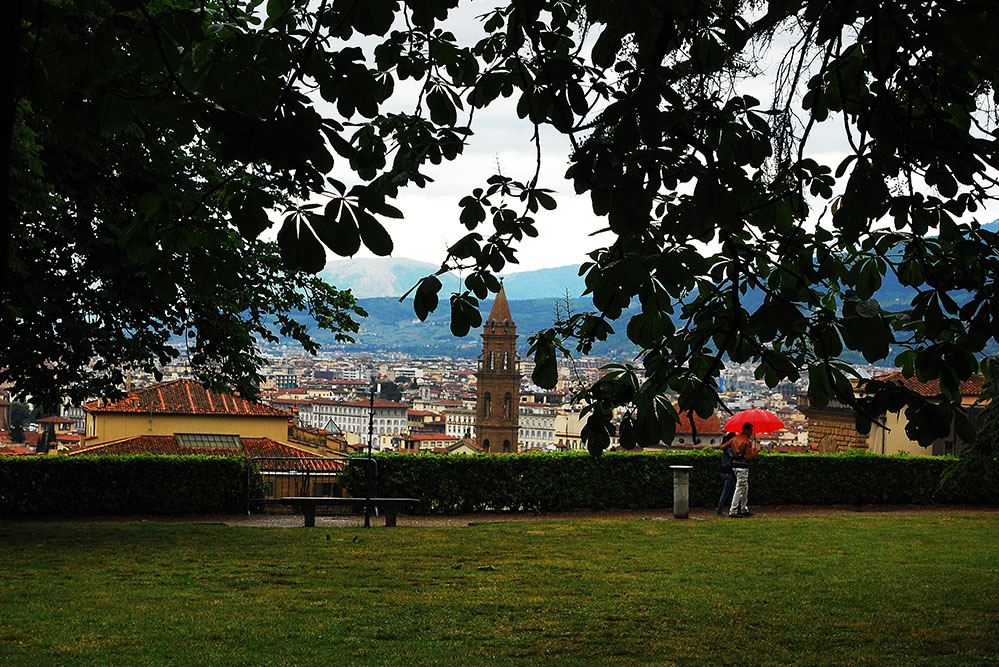
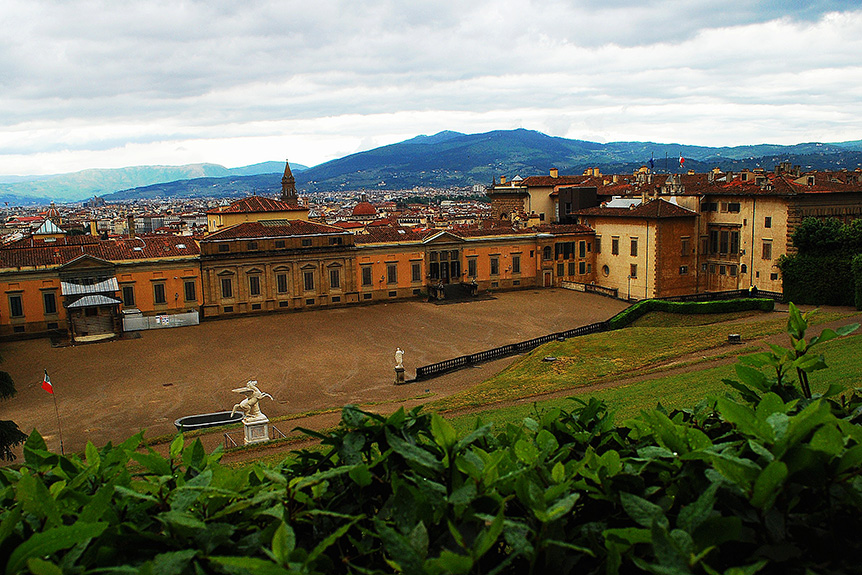
The Medici & their art heritage in a nutshell
Cosimo’s grandson, Lorenzo ‘il Magnifico’ (1449-1492), followed in grandfather’s footsteps and had a modern outlook on life. He supported, for example, new ideas and mythological themes by Sandro Botticelli. The connoisseur also founded the first art training in 1488. There he discovered the exceptional talent of thirteen-year-old Michelangelo Buonarroti, whom he took care of. Michelangelo grew up between heirs Giovanni (Pope Leo X) and cousin Giulio (Pope Clement VII), whom he later distanced himself from because of their dictatorship and turned his back on. His unparalleled David was finished in 1504 and after the victory of the republic became the symbol of an independent Florence, a free city without Medicine domination. When Florence entered an economic crisis, Giovanni was embraced again after ten years of exile. He entered the holy chair in 1513 and was received as a hero, for no one refuses the pope.
Cosimo I was the last Medici-telgium to make Florence the cultural centre of Italy and he was the first to lead a powerful army. He also had a strict regime, which brought him enemies, setbacks and wars. He founded the famous Galleria in Palazzo Pitti and Giorgio Vasari, a pupil of Michelangelo, became his right-hand man in the field of art.
The family’s success begins with Giovanni di Bicci (1360-1429) and his son, Cosimo ‘Il Vecchio’ (the Old one, 1389-1464). At the beginning of 1400, with their banking house, they cunningly invested in loyal customers with a strong political network, even the highest power in Rome. In addition to their financial and political success, father and son invested as much as possible in art talent, partly in order to enhance their (international) standing. Cosimo tolerated the rebellious characteristics of artists such as the hot-tempered Fillipo Brunelleschi, the womaniser Fillipo Lippi and the destructive Donatello. He gave them space and took risks, creating highly innovative art. Cosimo’s knowledge of and interest in classical antiquity was so great that he challenged Brunelleschi to use elements from classical antiquity – which had not been applied for more than a thousand years – to build an unevenly shaped dome for the cathedral of Santa Maria del Fiore. In 1436 his ‘mission impossible’ succeeded, which brought them both world-famous.
In 1737, however, the Medici’s male bloodline died out. From then on, Lorraine’s Franz Stephan seized power in Tuscany and he and his family were lurking over the art treasures of the dynasty. Anna Maria Luisa, one of the last in the Medici bloodline, had a far-sighted view on this. She made a clever pact for this, in which she donated her family’s entire inheritance to Florence. An invaluable expression of charity, because imagine what the city would have looked like if it had fallen into the wrong hands.
Practical
Get in there:
Several flights directly via Florence airport or an hour by train via Pisa.
Stay:
Hotel Palazzo Vecchio *** | Via Cennini 4 | hotelpalazzovecchio.it Va. €100/120 p.p.p.n. | Ideal location, next to the central train station. Attractive rooms (no. 22) overlooking the duomo
Villa La Petraia:
Via della Petraia 40 | Opening hours: depending on the season. On average between 8.15 and 16.30 hrs; Mon. closed. Costs: free of charge. Every 45 minutes there is a guided tour with an Italian-speaking (!) guide. The Villa is located 8 kilometers outside the center and is easily accessible by bus. Bus departures: every ten minutes from Piazza Adula/Via Fiume (next to the train station). Tickets: for sale at kiosks or on the bus.| Bus lines: line 2 direction Calenzano or number 28 direction Volpaia. | Stop & route: Sestese 4. Walk back a bit and turn left. Walk out of this side street and turn left again, from there follow the signs. It is about 1 km walking.
Other tip: Villa In Castello (Via di Castello 47). You can also visit it on foot from Petraia.
Palazzo’s
Medici Riccardi:
Via Carvour 1, (entrance at no. 3)| Opening hours: 9.00-19.00 hrs; closed on Wednesday | Cost: €5/€7 (for exhibitions).
Vecchio:
Piazza Signoria|Opening hours: 9.00 – 24.00 hrs; do 14.00 hrs.|Costs: €6
Pitti & Boboli gardens:
Piazza Pitti 1| Cost: €8,50 (for palace and two museums) €11,50: for everything, valid for three days.
Medici Chapel:
Piazza Madonna degli Aldobrandini| Opening Hours: 8.15-16.50 hrs, Mon. closed| Cost: €6
San Lorenzo:
Piazza San Lorenzo|Opening hours: 10.00-17.00 hours, 1/3-31/10, Sunday: 13.30-1700 hours|Costs: €3.50/ €6 + access to the library.|Opening hours: 8.15-18.50 hours; ma. closed
Sources & interesting literature for deepening (for sale at various museums):
- Agon guide to Florence, by Eve Borsook, publisher Agon, 1988 (for sale in the Netherlands)
- The Medici, Story of a European Dynasty , by Franco Cesati, La Mandragora, 1999.
- Dvd: I Medici, Signori del Rinascimento, Cinehollywood, 2007 (in English)
- Pitti Palace, all the museums, all the works , by Marco Chiarini, Sillabe publishing house, 2001
- The Medici Villas, by Isabella Lapi Ballerini, publishing house Giunti, 2006.

